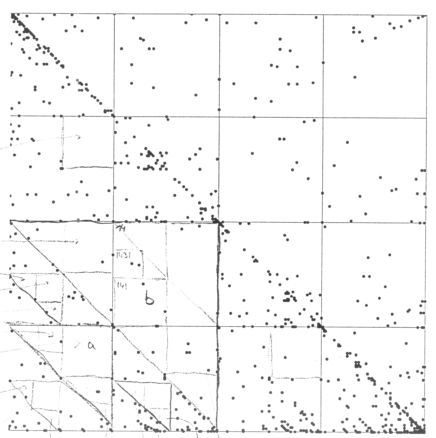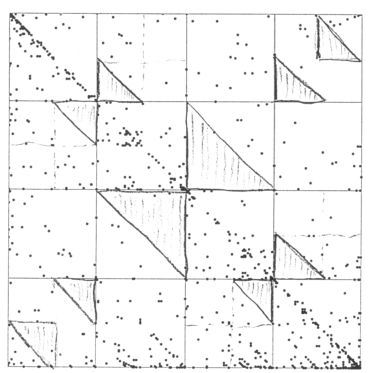| The first experiment involved the distance of the shots. |
| bin | shot | purpose |
| 1 | extreme long and long | show the spatial relations among the
important figures |
| 2 | medium and medium close-up | show two characters in conversation |
| 3 | close-up | shows facial features during conversations |
| 4 | extreme close-up | final shot in a build-up of tension, or part of
a fast action sequence |
|
| Here is the IFS of Pulp Fiction, driven by shot distance.
The triangles on the right will be explained in a moment. |
|
| Schneider made these interpretations. |
| * The faint gasket appearing results from the relatively low number
of extreme close-ups (bin 4), about 6%. |
| * Frequent combinations of close-ups and medium close-ups
(bins 2 and 3) explain the strong diagonal. |
| * Schneider speculated that in more
standard movies the squares 141 and 1431 would contain no points because they
represent juxtapositions of extreme close-ups and extreme long-shots. The interlocking
plot lines in Pulp Ficution validate these combinations. |
| Looking at the diagonal led Schneider to an interesting observation. |
| * Although the points are not even approximately symmetrically distributed across the
diagonal, some empty triangles are. |
| These, too, he related to the jerkiness of 14 and 41
combinations. |
| However, the situation is complicated by the presece of some points in
the squares 14 and 41. |
| The empty triangle in square 41 is made up of squares 411, 4131,
4121, and so on. |
| Speculations about these squares leads to the question of whether they
are empty because of a true exclusion, or because not enough data is present. |
| Of course,
we cannot add more shots to a film (Schneider counted 1029 in Plup Fiction), but we can
exercise some caution about how small an empty square we trust. |
| For instance, there are
46 = 4096 squares with length 6 address. With only 1029 points in the plot,
most length 6 address squares will be empty, whether or not the address represents an
impossible combination. |

